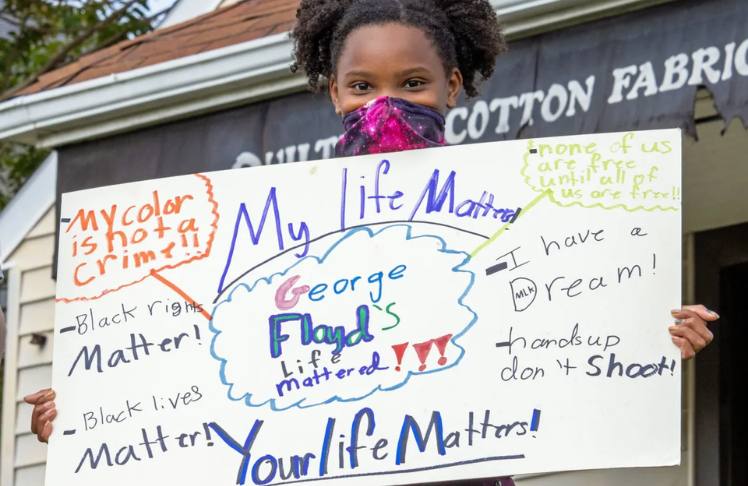
by Aziah Siid
This story is part of ” All Those ‘Racial Reckoning’ Promises” Word In Black’s series exploring the pledges made to the Black community following the Summer of George Floyd and what organizations and leaders can still do now to promote racial equity and justice.
It was a viral video that changed the world: The nearly 10-minute-long clip of the murder of George Floyd. But what’s sometimes forgotten is that a high school student, 17-year-old Darnella Frazier, filmed the video.
And the impact of Floyd’s murder on public education is undeniable. It catalyzed a course-changing wave of student-led protests, calls to defund school police, and even requests to revisit and revise how race is taught in the classroom.
This nationwide reckoning underlined an urgent need to confront racism, fostering a candid dialogue about the history of oppression faced by Black Americans.
Since then, toolkits, like teaching material on how to teach about the George Floyd murder trial, mental health resources, and new curricula have emerged as ways to foster productive conversations with students about race and the civil disobedience surrounding it. Some districts — some more than others — attempted to change. Here is what some folks did across the nation.
The Educators Approach
Tyrone Howard, a professor of education at the University of California and president of the American Educational Research Association, looks at research, advocacy, and policy tied to the educational landscape.
In the wake of the deaths of George Floyd, Ahmaud Arbery, and Breonna Taylor, Howard wrote, How to Root Out Anti-Racism From Your School, to directly speak on the role public education spaces need to do to address racism.
“School districts have to start to do their own inventory analysis,” Howard says. “I think schools sometimes have no idea about the kinds of patterns and practices that consistently eliminate and leave Black students on the sidelines.”
For example, culturally relevant teaching has been spoken about for decades by Black educators who’ve dedicated their lives to ensuring students’ success, but Floyd’s death propelled the conversation to the mainstream.
Howard proposes four concrete steps to ensure anti-Black racism is curbed in schools: acknowledging anti-Black racism explicitly, trusting Black students, halting opposition to “Black Lives Matter,” and promoting Black excellence.
“For many students, the fear is real, their anger is palpable, anxiety is high, and sadness is running deep,” Howard says. “Do not expect that you will have all the answers. Just listen to and affirm your students. Please do not make things business as usual.”
Howard mentions the need for schools to continue reevaluating factors stifling Black student progression, like the racial disparities in Advanced Placement course enrollment or access to other rigorous classes such as dual-enrollment courses.
Culturally relevant teaching — and increasing the number of Black teachers — has been spoken about for decades by Black educators who’ve dedicated their lives to ensuring students’ success. But, tragedies like Floyd’s death propelled the conversation to the mainstream.
School Districts Attempt At Inclusivity
Chicago Public Schools introduced the “Say Their Name” toolkit for staff, family members, and community members to recommit themselves to serving Black students. Asking questions like “What resources can I use to help young people understand the context of the present-day?” and “How can I be an anti-racist educator?” are just two questions that educators are encouraged to ask themselves.
In addition, an increased pressure for teachers and educators to partake in mandated racial equity training was a sign that there is a move in the right direction.
But let’s be clear. Change isn’t universal. There have been disturbing incidents, like a high school teacher in New York who gave an assignment stating George Floyd died due to a heart attack and drug overdose rather than because a police officer knelt on his neck.
Increased Social-Emotional Support
2020 was difficult to digest, especially for low-income Black families trying to stay afloat. Managing remote learning, keeping students active, and addressing their emotional well-being was no easy task.
Schools, especially in underserved communities, were already struggling to provide adequate counseling and mental health services. Now the rise in youth suicide rates and more than one-third of all U.S. high school students reporting unfair racial or ethnic treatment at school have only underscored the reality: Students are suffering, and racism in schools is a public health issue.
In response to this crisis, earlier this year, the U.S. Department of Education announced awards of more than $188 million to increase school-based mental health services.
“These grants will enable communities to hire approximately 5,400 school-based mental health professionals and train an estimated 5,500 more to build a diverse pipeline of mental health providers in schools,” according to the press release.
In addition to building up the direct mental health pipeline in schools, hundreds of hotlines and pro-bono therapy options are a bit more accessible for students. Organizations like Therapy for Black Girls and Black Girls Smile are available for those who seek therapy, and crisis hotlines can be called anytime.
But Black Students Still Need More
In reality, while there is work being done for the betterment of Black students, efforts like the push to stop Critical Race Theory, and other efforts to silence Black student voices continue to prevail nationwide.
“Adults have to do what I call race work, where they need to be introspective about their beliefs, about their biases, some of their behaviors, and actions with Black students,” Howard says. “The adults are the ones who have low expectations of Black students.















